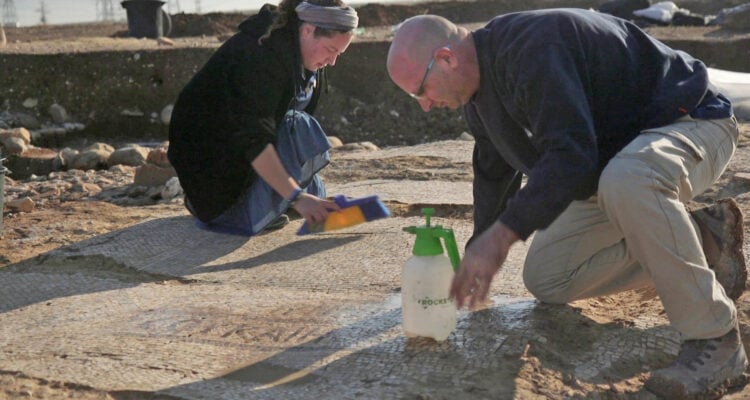1,500-year-old Byzantine monastery, featuring mosaic with Greek inscription of a verse from the Book of Deuteronomy, discovered near Kiryat Gat.
By World Israel News Staff
An ancient Christian monastery, dating back to the Byzantine period, was discovered in southern Israel recently, the Israel Antiquities Authority announced Monday morning.
During excavations north of Kiryat Gat, conducted ahead of plans to build a new neighborhood, IAA teams discovered a colorful monastery floor, along with a Greek inscription of a biblical verse.
The excavation revealed the remains of at least ten buildings, including the monastery, the winepress and a large warehouse building.
The monastery is dated to the Byzantine period (5th-6th centuries CE), and it is part of an ancient site that already existed during the Roman period and continued for approximately 600 years.
The findings revealed in the monastery and its environs include a great quantity of imported ware, coins, marble elements, metal and glass vessels, all attesting to the rich and significant community living here.
The monastery’s mosaic floor features crosses, lions, doves, an amphora (a ceramic maritime shipping jug), flowers and geometric patterns.
In its center, the ancient inscription in Greek was set — “Blessed are you when you come in, and blessed are you when you go out” (Deuteronomy 28:6). The mosaic’s geometric patterns incorporate very small mosaic stones, which served to highlight the cross-shaped decorations.
In addition to the monastery, a very sophisticated wine press was also uncovered, which was built and repaired several times over the years.
The mosaic flooring of the fermentation rooms and the collecting vat integrated blue and white stones. In the plastered surfaces of the collecting vats you can see remnants of red paint.
The northern collecting vat floor is built of slabs, upon some of which can be still be seen Greek letters, which served as masonry marks for the winepress builders.
All of these features indicate that building and developing this winery involved significant financial resources, time, and a range of professional work and effort.
According to Shira Lifshitz and Maayan Margulis, excavation managers on behalf of the Israel Antiquities Authority, “The early settlement is sited on a central road junction connecting the mountain region to the coastal plain.”
“It apparently served the area’s smaller settlements as well as travelers passing by. This is the largest and most significant Roman and Byzantine period site uncovered in this area. The findings indicate a succession of settlement starting from the early Roman period (1st century CE) and through until the end of the Byzantine period (end of the 6th century CE).”
The Roman period settlement remains are more limited, but even they display richness in the variety and quality of the finds.
In the Byzantine period one can see the settlement’s significant expansion, which included the construction of the monastery and the winepress.
In addition, there is much evidence of local pottery production, such as detritus typical of a ceramic factory, garbage pits, misshapen vessels that were flawed in production, and even a number of vessels unique to this site.
“The discovery of the site highlights the historical richness of Kiryat Gat and its surroundings, shedding light on the centrality of the region in antiquity,” said Svetlana Talis, Director of the Southern Region at the Israel Antiquities Authority.
“The mosaic floor will be relocated to an open area in the city and made accessible to the public.”
“The mosaic discovered in Kiryat Gat is one of the most unique ever found in Israel,” adds Mark Avrahami, Head of Artistic Conservation at the Israel Antiquities Authority.
“Transferring mosaics is a complex process that requires great skill and precision. Soon, the ancient mosaic will be moved to the Israel Antiquities Authority’s mosaic workshop for preservation before being displayed in the city.”





